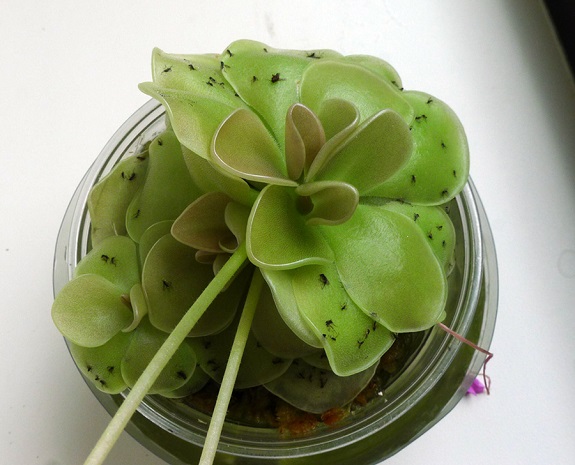
They flit across your face, hover near your houseplants, or gather by the window. Fortunately, these fungus gnats are more annoying to us than harmful to our plants. This pest finds its way into our homes on plants added to our indoor houseplant collection or those moved inside after a summer outdoors. Some may enter on organically rich, non-pasteurized soil.
The small, 1/8-inch adult resembles a fruit fly or mosquito but does not feed on overripe fruit and vegetables and it does not bite. Adults live for only seven to ten days, but the female can lay up to 200 eggs in the cracks and crevices of moist soil in that short time. Eggs hatch releasing worm-like larvae with black heads and elongated white or clear legless bodies. The larvae begin feeding in the top two to three inches of soil, dining on fungi, algae, and organic matter and occasionally plant roots and leaves on the soil surface.
Plant damage is usually insignificant. If conditions are right, fungus gnat populations can reach damaging levels, resulting in root damage that leads to wilting and stunted growth. Over and under watering, over fertilization and other environmental factors are more likely the causes of these symptoms. Provide proper care to reduce the risk of this type of damage.
Fungus gnat populations on houseplants seldom reach levels that require control for the plant’s health and longevity. The adults can be annoying, especially to the non-gardeners in the family, and are often the motivation for managing this pest.
Start control by adjusting your watering practices. Since fungus gnats thrive in moist soil, avoid overwatering. Allow the top few inches of soil to dry between thorough waterings. Pour off excess water that collects in the saucer to avoid root rot. Or place pebbles in the saucer to elevate the pot above any excess water that collects in the tray.
Adjust your watering schedule with the change of the season. As day length and light intensity change throughout the year and heat and air conditioning is employed, a plant’s water needs change as well.
Use containers with drainage holes or self-watering pots with overflow outlets, also known as weep holes, to avoid waterlogged soils. Refresh potting mix as needed. Older planting mixes degrade over time, retaining moisture longer and creating an inviting environment for fungus gnats.
One way to manage unwanted fungus gnats is with an organic Bacillus thruingiensis israelensis (BTI) product such labeled for controlling fungus gnat larvae. Just sprinkle it on the soil surface and this naturally occurring soil bacterium kills the fungus gnat larvae in the soil. It’s safe for people, pets, and plants. Read and follow label directions repeating as needed.
If your plants are in a greenhouse, you can also use predatory insects to eliminate fungus gnats. This article does a good job explaining which insects to get and how to use them. And this article explains how to use inexpensive hydrogen peroxide to eliminate fungus gnats.
Use yellow sticky traps to monitor adult populations. Place homemade or purchased traps on sticks in houseplant containers. Use 1/4-inch slices or wedges of potatoes to attract and monitor fungus gnat larvae. Stick a portion of the potato into the soil. Check for fungus gnats after a few days and replace the potato wedge to help manage this pest.
Understanding the fungus gnat and its preferred environment will help you safely and effectively manage this pest.
Melinda Myers has written more than 20 gardening books, including Small Space Gardening. She hosts the “How to Grow Anything” DVD series and the Melinda’s Garden Moment TV & radio segments. Her website is MelindaMyers.com.
Related Articles & Free Email Newsletter
3 Simple Ways to Protect Hydroponic Plants from Pests
A Natural Insecticide to Use Against Plant-Eating Insects




Comment here